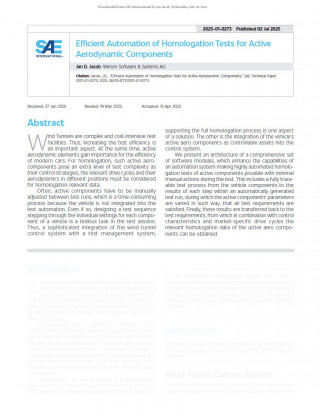Technical paper published: “Efficient Automation of Homologation Tests for Active Aerodynamic Components"
As part of the "FKFS 2025 Stuttgart International Symposium", a technical paper by Dr. Jan Jacob (Business Development Werum) has been published.

The author presents a software architecture for automating wind tunnel tests of vehicles with active aerodynamic components. The goal is to replace labor-intensive manual control with an integrated solution that enables efficient, traceable, and largely automated execution of homologation-relevant tests.
The paper can be purchased on the SAE International website: https://www.sae.org/publications/technical-papers/content/2025-01-0273/
More information:
HyperTest Boost – Test process management: https://www.werum.de/de/hypertest-boost
WTCS – Control system for large‑scale and component test beds: https://www.werum.de/de/wtcs
Abstract:
Wind Tunnels are complex and cost-intensive test facilities. Thus, increasing the test efficiency is an important aspect. At the same time, active aerodynamic elements gain importance for the efficiency of modern cars. For homologation, such active aero-components pose an extra level of test complexity as their control strategies, the relevant drive cycles and their aerodynamics in different positions must be considered for homologation-relevant data.
Often, active components have to be manually adjusted between test runs, which is a time-consuming process because the vehicle is not integrated into the test automation. Even if so, designing a test sequence stepping through the individual settings for each component of a vehicle is a tedious task in the test session. Thus, a sophisticated integration of the wind tunnel control system with a test management system, supporting the full homologation process is one aspect of a solution. The other is the integration of the vehicle’s active aero components as controllable assets into the control system.
We present an architecture of a comprehensive set of software modules, which enhance the capabilities of an automation system making highly automated homologation tests of active components possible with minimal manual actions during the test. This includes a fully traceable test process from the vehicle components to the results of each step within an automatically generated test run, during which the active components’ parameters are varied in such way, that all test requirements are satisfied. Finally, these results are transferred back to the test requirements, from which in combination with control characteristics and market-specific drive cycles the relevant homologation data of the active aero components can be obtained.
Jacob, J., "Efficient Automation of Homologation Tests for Active Aerodynamic Components," SAE Technical Paper 2025-01-0273, 2025, https://doi.org/10.4271/2025-01-0273.